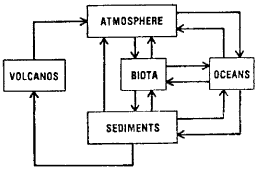 |
Science Frontiers ONLINE No. 48: Nov-Dec 1986 |
|
|
Geophysiology
The concept of the earth-as-an-organism -- the so-called Gaia hypothesis -- keeps popping up. We now have an excellent progress report on current Gaia research; e.g., the Daisyworld model; by J.E. Lovelock. He defines Gaia in an early paragraph:
"In the early 1970s, Lynn Margulis and I introduced the Gaia hypothesis. It postulated the earth to be a self-regulating system comprising the biota and their environment, with the capacity to maintain the climate and the chemical composition at a steady state favorable for life."
L. Margulis is an author of Micro-Cosmos and a champion of evolution-via-endosymbiosis; that is, diverse organisms uniting to create new species. Going back to Lovelock's review, there is little that is anomalous on a small scale. Of course, on a large-scale, the data supporting the concept of life-as-a-whole manipulating the atmosphere, oceans, etc., to perpetuate and perhaps improve itself are highly anomalous, because the Gaia hypothesis is far out of the scientific mainstream.
(Lovelock, James E.; "Geophysiology," American Meteorological Society, Bulletin, 67:392, 1986.)
Comment. Our secret purpose here is to use the Lovelock article as an excuse to out-Gaia Gaia! Lovelock's article plus those preceding on Martian life, cosmic life, "geocorrosion," etc., made us wonder if Gaia as a closed terrestrial system (see diagram), is not too limited. If Hoyle and Wickramasinghe are correct, the diagram should have a box labelled "outer space," with an inwardly directed arrow carrying life-forms (Hoyle's space viruses and bacteria), meteorites, icy comets, etc. Likewise, the earth can contribute life-forms to the cosmos via impact and volcanic ejecta. Where does geocorrosion fit in? Life-as-a-whole could control terrestrial magnetic field reversals geochemically. This sounds more and more like science fiction, but life-as-a-whole must "want" to evolve to make itself more adaptable and capable of controlling and exploring the cosmos. (These are anthropomorphic desires we assign to life-as-awhole, which may have completely different objectives!) By occasionally reducing the earth's field to zero, bursts of space radiation would be admitted to stir the earth's pot of genes. We could also work in "selfish genes" and God, but it is time to go back to anomalies once more.
